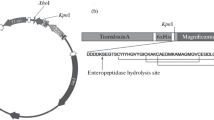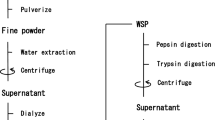Abstract
Purpose. The present study addresses how maltosyl-β-cyclodextrin (G2-β-CyD) impacts upon the α-chymotrypsin-catalyzed hydrolysis of buserelin acetate, an agonist of luteinizing hormone-releasing hormone with emphasis upon the direct effect of G2-β-CyD on the activity of the protease.
Methods. Kinetic and solubility studies were performed in isotonic phosphate buffer (pH 7.4) at 25°C and 37°C. The interaction of α-chymotrypsin with G2-β-CyD in the buffer solution was examined by differential scanning calorimetry.
Results. G2-β-CyD decelerated the α-chymotrypsin-catalyzed hydrolysis of buserelin acetate to give the 1−3 tripeptide and the 4−9 hexapeptide fragments. This deceleration can be explained solely by a nonproductive encounter between a complex of the substrate with G2-β-CyD and the protease at relatively low CyD concentrations, while the direct inhibitory effect of G2-β-CyD on the proteolytic activity made a considerable contribution to the overall deceleration of the hydrolysis at higher CyD concentrations. Calorimetric studies indicate the presence of intermediate states in the thermal unfolding of α-chymotrypsin, simultaneously accompanied by the autolysis. By contrast, a two-state thermal unfolding of α-chymotrypsin was observed in the presence of G2-β-CyD, suggesting reduced proteolytic activity upon binding to G2-β-CyD.
Conclusions. These results suggest that G2-β-CyD at higher concentrations inhibits the proteolytic action of α-chymotrypsin through direct interaction with the protease, as well as through the formation of a non-productive complex with the substrate.
Similar content being viewed by others
REFERENCES
R. N. Brogden, M. M.-T. Buckley, and A. Ward. Drugs 39:399-437 (1990).
S. C. Raehs, J. Sandow, K. Wirth, and H. P. Merkle. Pharm. Res. 5:689-693 (1988).
K. Matsubara, K. Abe, T. Irie, and K. Uekama. J. Pharm. Sci. 84:1295-1300 (1995).
K. Matsubara, T. Irie, and K. Uekama. Chem. Pharm. Bull. 45:378-383 (1997).
W. J. Irwin, A. K. Dwivedi, P. A. Holbrook, and M. J. Dey. Pharm. Res. 11:1698-1703 (1994).
T. Irie, K. Wakamatsu, H. Arima, H. Aritomi, and K. Uekama. Int. J. Pharm. 84:129-139 (1992).
H. Sawada, H. Yokosawa, M. Hoshi, and S. Ishii. Experientia 39:377-378 (1983).
R. L. Scott. Rec. Trav. Chim. 75:787-789 (1956).
T. Higuchi and K. A. Connors. Adv. Anal. Chem. Instrum. 4:117-212 (1965).
H. Fukuda, K. Takahashi, and J. M. Sturtevant. Biochemistry 24:5109-5115 (1985).
G. P. Hess. In P. D. Boyer (ed), The Enzymes, Vol. III, Academic Press, New York, pp. 213-248 (1971).
M. L. Bender and M. Komiyama. Cyclodextrin Chemistry, Springer-Verlag, Berlin, 1978.
V. N. Dorovska, S. D. Varfolomeyev, N. F. Kazanskaya, A. A. Klyosov, and K. Martinek. FEBS Lett. 23:122-124 (1972).
S. P. Kumble and C. S. Ramadoss. Biocatalysis & Biotransformation 12:281-291 (1995).
P. L. Privalov and N. N. Khechinashvili. J. Mol. Biol. 86:665-684 (1974).
J. F. Back, D. Oakenfull, and M. B. Smith. Biochemistry 18:5191-5196 (1979).
A. Cooper. J. Am. Chem. Soc. 114:9208-9209 (1992).
A. Cooper and D. D. MacNicol. J. Chem. Soc. Perkin Trans. 2 1978:760-763.
Author information
Authors and Affiliations
Corresponding author
Rights and permissions
About this article
Cite this article
Matsubara, K., Ando, Y., Irie, T. et al. Protection Afforded by Maltosyl-β-cyclodextrin Against α-Chymotrypsin-Catalyzed Hydrolysis of a Luteinizing Hormone-Releasing Hormone Agonist, Buserelin Acetate. Pharm Res 14, 1401–1405 (1997). https://doi.org/10.1023/A:1012120705408
Issue Date:
DOI: https://doi.org/10.1023/A:1012120705408




